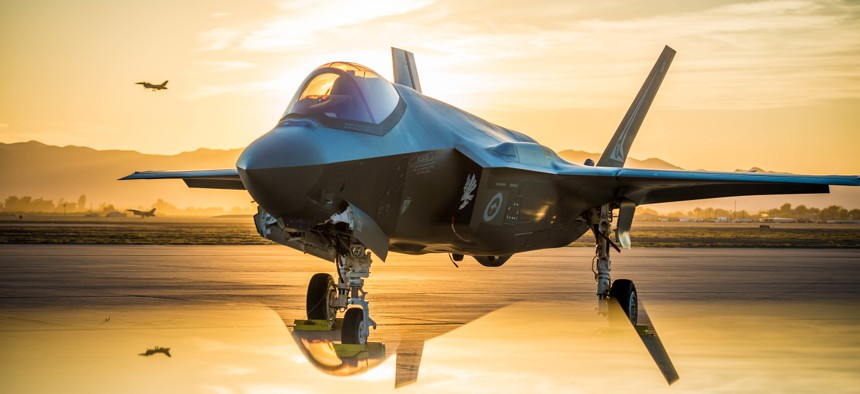
The sun sets behind an Australian F-35A Lighting II at Luke Air Force Base, Ariz., June 27, 2018. U.S. Air Force / Staff Sgt. Jensen Stidham
Can F-35 Engine Plan Get Foreign OK?
The U.S. Air Force decided to upgrade the existing engine instead of pursuing a new adaptive engine, and will likely talk to partners about the change later this year.
The Pentagon has not yet talked to its international partners about the future of the F-35 engine, and will likely have that discussion later this year, though it is already asking Congress to fund an engine upgrade for its entire fleet.
The Air Force recently decided it will upgrade the existing Pratt & Whitney engine through a program called engine core upgrade, or ECU, and not pursue a new, adaptive engine for its F-35 fleet. But that decision has not yet been discussed with international partners in the program, F-35 Program Executive Officer Lt. Gen. Michael Schmidt said Monday.
“They are aware of the costs and what their cost share would be, and I would expect that we would have a discussion” about it late this September, Schmidt told Defense One on the sidelines of the annual Sea-Air-Space conference.
Twice a year, the U.S. and its seven F-35 partners—U.K., Italy, Netherlands, Canada, Australia, Denmark, and Norway—meet for a “Joint Strike Fighter executive steering board” to set the program’s priorities, Schmidt said.
“They have invested in the development of this program along with the United States. They together pay about 20 percent of all the development costs in this program and they get a vote,” Schmidt said.
The Air Force wants to spend $254 million in 2024 for the ECU program, according to its budget request sent to Congress in early March, and hopes all F-35 customers will help fund the cost of the upgrade.
Since Russia began its invasion of Ukraine, four countries have committed to buying F-35s, which U.S. defense officials have pointed to as proof that NATO is stepping up to the plate to deter Russia.
The Joint Strike Fighter program aims to operate 500 to 600 F-35s in Europe by 2034, which will be a “huge opportunity” to “leverage each other's logistics and maintenance environments,” Schmidt said.
However, a growing fleet size also brings an “enormous sustainment network” with it, Schmidt said, and requires a significant depot presence in the U.S and in its partner nations, as well as some other countries.
“I think we were a little bit late in standing up some of our depots to deal with the capacity that we need to get to, but I would say in just [the] lot 15 to 17 negotiation we actually held back on the urge to buy aircraft with depot stand-up money and held our own to keep that money available to stand up depots. That's a huge win,” Schmidt said.
Because maintenance costs are expected to account for the majority of F-35 costs over the aircraft’s lifetime, the program is shifting to a new contract method to acquire parts and services from industry.
At the end of this year, the program will move to a “performance-based logistics” contract instead of a transactional supply contract to improve speed and reduce cost, Bridget Lauderdale, vice president of the F-35 program at Lockheed Martin, said at Sea-Air-Space.
A performance-based logistics contract buys performance or outcomes, rather than purchasing parts or services.
“The theory and the concept is that'll move a lot faster than having to do it transactionally, so we're excited to get started in that space, and that's not just Pratt & Whitney LM, that would be the entire industry participating in those pieces,” Lauderdale said.
NEXT STORY: Milley: Don’t Send Uninvited US Troops to Mexico


